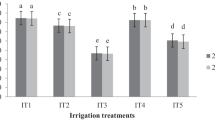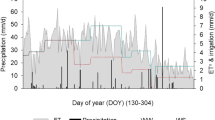Abstract
In irrigated agriculture, the production of biomass and marketable yield depend largely on the quantity and salinity of the irrigation water. The sensitivity of field-grown muskmelon (Cucumis melo L. cv. “Galia”) to water deficit was compared, using non-saline (ECi= 1.2 dS m−1) and saline (ECi=6.3 dS m−1) water. Drip irrigation was applied at 2-day intervals at seven different water application rates for each water quality, including a late water-stress treatment. Neutron scattering measurements showed that the soil layers below the root zone remained dry throughout the experiment, indicating negligible deep percolation. Thus, the sum of the seasonal amount of applied water and the change in soil moisture approximated the cumulative evapotranspiration (ET). Gradual buildup of water and salt stresses resulted in small treatment effects on the size of the vegetative cover and large effects on leaf deterioration and fruit production. Crop responses to salinity may result from an osmotic component of the soil water potential or from other salt effects on the crop physiology. Relating plant data to cumulative ET allowed a distinction to be made between the effect on water availability and specific salinity effects. The relation between fruit fresh weight and ET was not sensitive to ECi. The slopes for fruit dry weights were also insensitive to ECi but the intercept was larger for saline treatments. At any given ET saline water increased fruit number, increased fruit dry matter content and decreased fruit netting, in comparison with non-saline water. The combination of salinity and soil-water deficit was detrimental to fruit quality. Saline soil-water deficit decreased the percentage of marketable (netted) fruit and caused an early end to the period of marketable fruit production. Non-saline soil-water deficit increased the percentage of marketable fruit and had no effect on the duration of the production period. Late non-saline water stress caused a pronounced increase in the percentage of marketable fruit.
Similar content being viewed by others
References
Boote KJ, Stangell JR, Schubert AM, Stone JF (1982) Irrigation, water use and water relations. In: Pattee HE, Young CT (eds) Peanut science and technology. Peanut Res Educ Soc Inc, Yoakum, Texas, pp 164–205
Cardon GE, Letey J (1992) Soil-based irrigation and salinity management model. I. Plant water uptake calculations. Soil Sci Soc Am J 56:1881–1887
Childs SW, Hanks RJ (1975) Model for soil salinity effect on crop growth. Soil Sci Soc Am Proc 39:617–622
de Witt CT (1958) Transpiration and crop yields. Versl Landbouwkd Onderz 64:1–88
Hsiao TC (1993) Growth and productivity of crops in relation to water status. Acta Hortic 335:137–148
Heuer B, Plaut Z (1989) Photosynthesis and osmotic adjustment of two surgarbeet cultivars grown under saline conditions. J Exp Bot 40:437–440
Ismail AM, Hall AE (1992) Correlation between water-use efficiency and carbon isotope discrimination in diverse cowpea genotypes and isogenic lines. Crop Sci 32:7–12
Maas EV, Hoffman GJ (1977) Crop salt tolerance: evaluation of existing data. Proc Int Salinity Conf Texas Tech Univ, Lubbock, Texas, pp 187–198
Mahalakshmi V, Bidinger IR, Rao GDP (1988) Timing and intensity of water deficits during flowering and grain-filling in pearl millet. Agron J 80:130–135
McCree KJ (1986) Whole-plant carbon balance during osmotic adjustment to drought and salinity stress. Aust J Plant Physiol 13:33–43
McCree KJ, Richardson SG (1987) Salt increases the water use efficiency in water stressed plants. Crop Sci 27:543–547
Meiri A, Kamburov J, Shalhevet J (1977) Transpiration effects on leaching fractions. Agron J 69:779–782
Meiri A, Plaut Z, Pincas L (1981) Salt tolerance of glasshouse-grown muskmelon. Soil Sci 131:189–193
Meiri A, Hoffman GJ, Shannon MC, Poss JA (1982) Salt tolerance of two muskmelon cultivars under two radiation levels. J Am Soc Hort Sci 107:1168–1172
Meiri A, Frenkel H, Mantel A (1992) Cotton response to water amount and salinity under sprinkler and drip irrigation. Agron J 84:44–50
Mendlinger S, Pasternak D (1992a) Effect of time of salinization on flowering, yield and fruit quality factors in melon, Cucumis melo L. J Hort Sci 67:529–534
Mendlinger S, Pasternak D (1992b) Screening for salt tolerance in melons. HortScience 27:905–907
Pew WD, Gardner BR (1983) Effects of irrigation practices on vine growth, yield, and quality of muskmelons. J Am Soc Hort Sci 108:134–137
Richardson SG, McCree KJ (1985) Carbon balance and water relations of sorghum exposed to salt and water stress. Plant Physiol 79:1015–1020
Russo D (1987) Lettuce yield-irrigation water quality and quantity relationships in a gypsiferous desert soil. Agron J 79:8–14
Russo D, Bakker D, (1987) Crop-water prodcution functions for sweet corn and cotton irrigated with saline water. Soil Sci Soc Am J 51:1554–1562
Schwartz M, Gale J (1981) Maintenance respiration and carbon balance of plants at low levels of sodium chloride salinity. J Exp Bot 32:933–941
Shalhevet J (1984) Management of irrigation with brackish water. In: Shainberg I, Shalhevet J (eds) Soil salinity under irrigation. Processes and Management, Springer, Berlin, pp 298–318
Shannon MC, Francois LE (1978) Salt tolerance of three muskmelon cultivars. J Am Soc Hort Sci 103:127–130
Shone M, Gale J (1983) Effect of sodium chloride stress and nitrogen source on respiration, growth and photosynthesis in lucerne. J Exp Bot 34:1117–1125
Author information
Authors and Affiliations
Rights and permissions
About this article
Cite this article
Meiri, A., Lauter, D.J. & Sharabani, N. Shoot growth and fruit development of muskmelon under saline and non-saline soil water deficit. Irrig Sci 16, 15–21 (1995). https://doi.org/10.1007/BF00208391
Received:
Issue Date:
DOI: https://doi.org/10.1007/BF00208391




